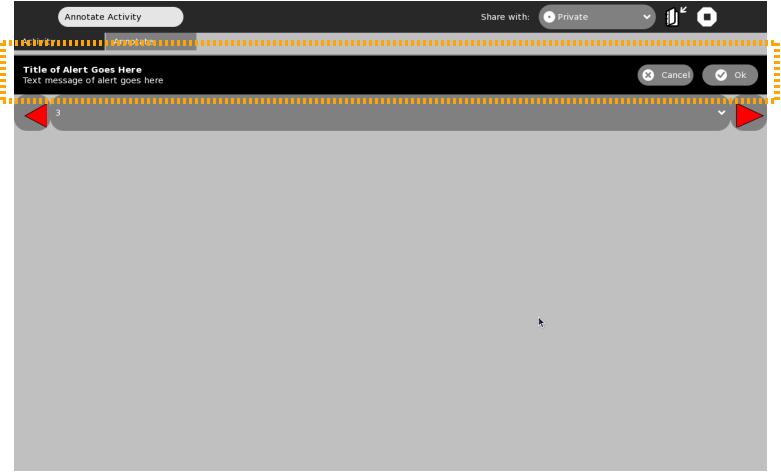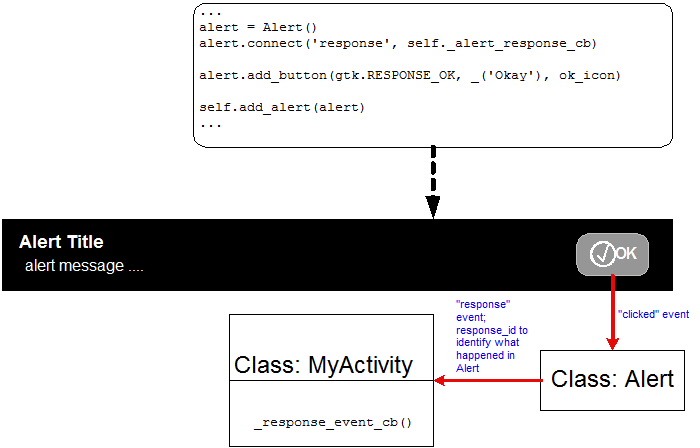Sugar.graphics.alert: Difference between revisions
No edit summary |
No edit summary |
| (One intermediate revision by the same user not shown) | |
(No difference)
| |
Latest revision as of 03:10, 2 October 2008
Class: Alert
Alerts appear at the top of the body of your activity, just below the toolbox if it is visible. The image below shows what a simple alert looks like.
At a high level, Alert and its different variations (TimeoutAlert, ConfirmationAlert, etc.) have a title, an alert message and then a bunch of buttons that the user can click. The diagram shows that when you create Alert objects in your code, each button is connected to a specific response_id (in this case, gtk.RESPONSE_OK). The Alert class will pass "response" events to your activity when any of these buttons are clicked, along with a response_id to help you identify what button was clicked.
How do I create a simple alert message?
You can create the most basic alert message by first creating a new instance of the Alert class and then calling the add_alert() method for your activity.
from sugar.graphics.alert import Alert
...
# Create a new simple alert
alert = Alert()
# Populate the title and text body of the alert.
alert.props.title=_('Title of Alert Goes Here')
alert.props.msg = _('Text message of alert goes here')
# Call the add_alert() method (inherited via the sugar.graphics.Window superclass of Activity)
# to add this alert to the activity window.
self.add_alert(alert)
alert.show()
How do I create an alert message with a button that allows a user response to the alert?
The _alert_user() method below is called to alert the user about something (here it is very generic). In this example, we add a simple 'OK' button that the user can click. When this button is clicked, the _alert_response_cb() method gets called, which removes the alert from the screen.
from sugar.graphics.alert import Alert
...
def _alert_user(self):
# Create a new simple alert
alert = Alert()
# Populate the title and text body of the alert.
alert.props.title=_('Title of Alert Goes Here')
alert.props.msg = _('Text message of alert goes here')
#Add an 'OK' Button
ok_icon = Icon(icon_name='ok-button')
ok_icon.set_pixel_size(50)
alert.add_button(gtk.RESPONSE_OK, _('Okay'), ok_icon)
alert.connect('response', self._alert_response_cb)
# Call the add_alert() method (inherited via the sugar.graphics.Window superclass of Activity)
# to add this alert to the activity window.
self.add_alert(alert)
alert.show()
def _alert_response_cb(self, alert, response_id):
if response_id is gtk.RESPONSE_OK:
self.remove_alert(alert)
Class: ConfirmationAlert
What is special about a confirmation alert and how do I use it in my activity?
A confirmation alert is a nice shortcut from a standard Alert because it comes with 'OK' and 'Cancel' buttons already built-in. When clicked, the 'OK' button will emit a response with a response_id of gtk.RESPONSE_OK, while the 'Cancel' button will emit gtk.RESPONSE_CANCEL.
The code below shows how a ConfirmationAlert is created. It also shows a response method that takes care of one of the two action buttons being clicked.
from sugar.graphics.alert import ConfirmationAlert
...
#### Method: _alert_confirmation, create a Confirmation alert (with ok and cancel buttons standard)
# and add it to the UI.
def _alert_confirmation(self):
alert = ConfirmationAlert()
alert.props.title=_('Title of Alert Goes Here')
alert.props.msg = _('Text message of alert goes here')
alert.connect('response', self._alert_response_cb)
self.add_alert(alert)
#### Method: _alert_response_cb, called when an alert object throws a response event.
def _alert_response_cb(self, alert, response_id):
#remove the alert from the screen, since either a response button was clicked or
#there was a timeout
self.remove_alert(alert)
#Do any work that is specific to the type of button clicked.
if response_id is gtk.RESPONSE_OK:
print 'Ok Button was clicked. Do any work upon ok here ...'
elif response_id is gtk.RESPONSE_CANCEL:
print 'Cancel Button was clicked.'
Class: TimeoutAlert
What is special about a TimeoutAlert and how do I use it in my activity?
A TimeoutAlert is a special type of alert with two standard buttons ('Cancel' and 'Continue'). This alert also times out after a given number of seconds, returning with a positive response.
In the code below, we create a TimeoutAlert that will send a positive signal in 10 seconds if the user does not click any of the buttons. The callback method detects that a timeout occurred by checking that the response_id parameter is -1. If so, it simply removes the alert and prints out 'Timeout occurred'.
from sugar.graphics.alert import TimeoutAlert
...
#### Method: _alert_timeout, create a Timeout alert (with ok and cancel buttons standard)
# and add it to the UI.
def _alert_timeout(self):
#Notice that for a TimeoutAlert, you pass the number of seconds in which to timeout. By
#default, this is 5.
alert = TimeoutAlert(10)
alert.props.title=_('Title of Alert Goes Here')
alert.props.msg = _('Text message of timeout alert goes here')
alert.connect('response', self._alert_response_cb)
self.add_alert(alert)
#### Method: _alert_response_cb, called when an alert object throws a response event.
def _alert_response_cb(self, alert, response_id):
#remove the alert from the screen, since either a response button was clicked or
#there was a timeout
self.remove_alert(alert)
#Do any work that is specific to the type of button clicked.
if response_id is gtk.RESPONSE_OK:
print 'Ok Button was clicked. Do any work upon ok here ...'
elif response_id is gtk.RESPONSE_CANCEL:
print 'Cancel Button was clicked.'
elif response_id == -1:
print 'Timout occurred'
Class: NotifyAlert
What is special about a NotifyAlert and how do I use it in my activity?
A NotifiyAlert is just like a TimeoutAlert except that it has only an 'OK' button. It is used just for user notifications. For brevity, no response callback method is included below; it would be just like the other alerts discussed thus far.
from sugar.graphics.alert import NotifyAlert
...
#### Method: _alert_notify, create a Notify alert (with only an 'OK' button)
# and add it to the UI.
def _alert_notify(self):
#Notice that for a NotifyAlert, you pass the number of seconds in which to notify. By
#default, this is 5.
alert = NotifyAlert(10)
alert.props.title=_('Title of Alert Goes Here')
alert.props.msg = _('Text message of notify alert goes here')
alert.connect('response', self._alert_response_cb)
self.add_alert(alert)

